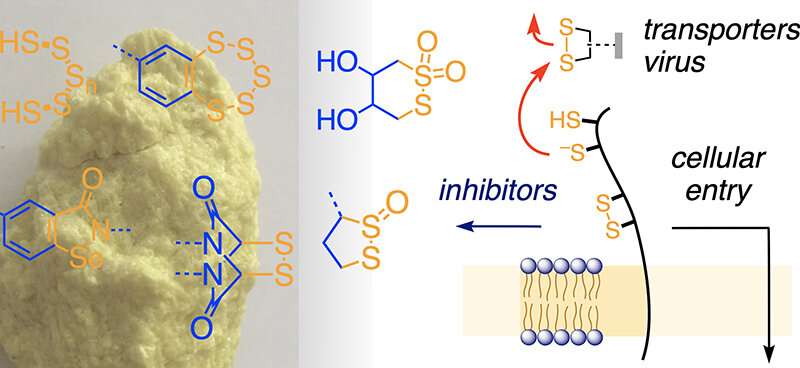HOME
A sulfur molecule to block the coronavirus

In thiol-mediated uptake, dynamic covalent exchange with thiols on the cell surface precedes entry through different mechanisms. Inhibition of thiol-mediated uptake by removal of exofacial thiols could thus afford new antivirals. Credit: UNIGE/MATILE.
The cell membrane is impermeable to viruses—to get inside and infect a cell, they use a range of strategies to exploit the cellular and biochemical properties of the membranes. The thiol-mediated uptake of organic molecules similar to alcohols, where oxygen is replaced by a sulfur atom, is one such entry mechanisms used by the human immunodeficiency virus (HIV), as demonstrated a few years ago. No effective inhibitor is currently available because of the robustness of the chemical reactions and bonds at work. A research group from the University of Geneva (UNIGE) has now identified inhibitors that are up to 5,000 times more effective than the one most often used today. Preliminary tests—published and available free of charge in Chemical Science, the flagship journal of the Royal Society of Chemistry—demonstrate the blocking of the cellular entry of viruses expressing the SARS-CoV-2 proteins. The study paves the way for research into new antivirals.
Since 2011, the laboratory led by Professor Stefan Matile in UNIGE's Department of Organic Chemistry, has been investigating the way thiols react with other structures containing sulfides, molecules in which sulfur is combined with another chemical element. "These are very special chemical reactions because they can change state dynamically," begins Professor Matile. In fact, covalent bonds, based on sharing electrons between two atoms, freely oscillate between sulfur atoms, depending on conditions.
Sulfur compounds are present in nature, particularly on the membrane of eukaryotic cells and on the envelope of viruses, bacteria and toxins. Studies suggest that they play a role in one of the mechanisms—known as thiol-mediated uptake—that enables the very difficult passage from outside to inside the cell. This key step involves the dynamic bond between thiols and sulfides. "Everything that approaches the cell can connect to these dynamic sulfur bonds," continues Professor Matile. "They cause the substrate to enter the cell either by fusion or endocytosis, or by direct translocation through the plasma membrane into the cytosol." Studies a few years ago showed that the entry of HIV and diphtheria toxin use a mechanism involving thiols.
News Source